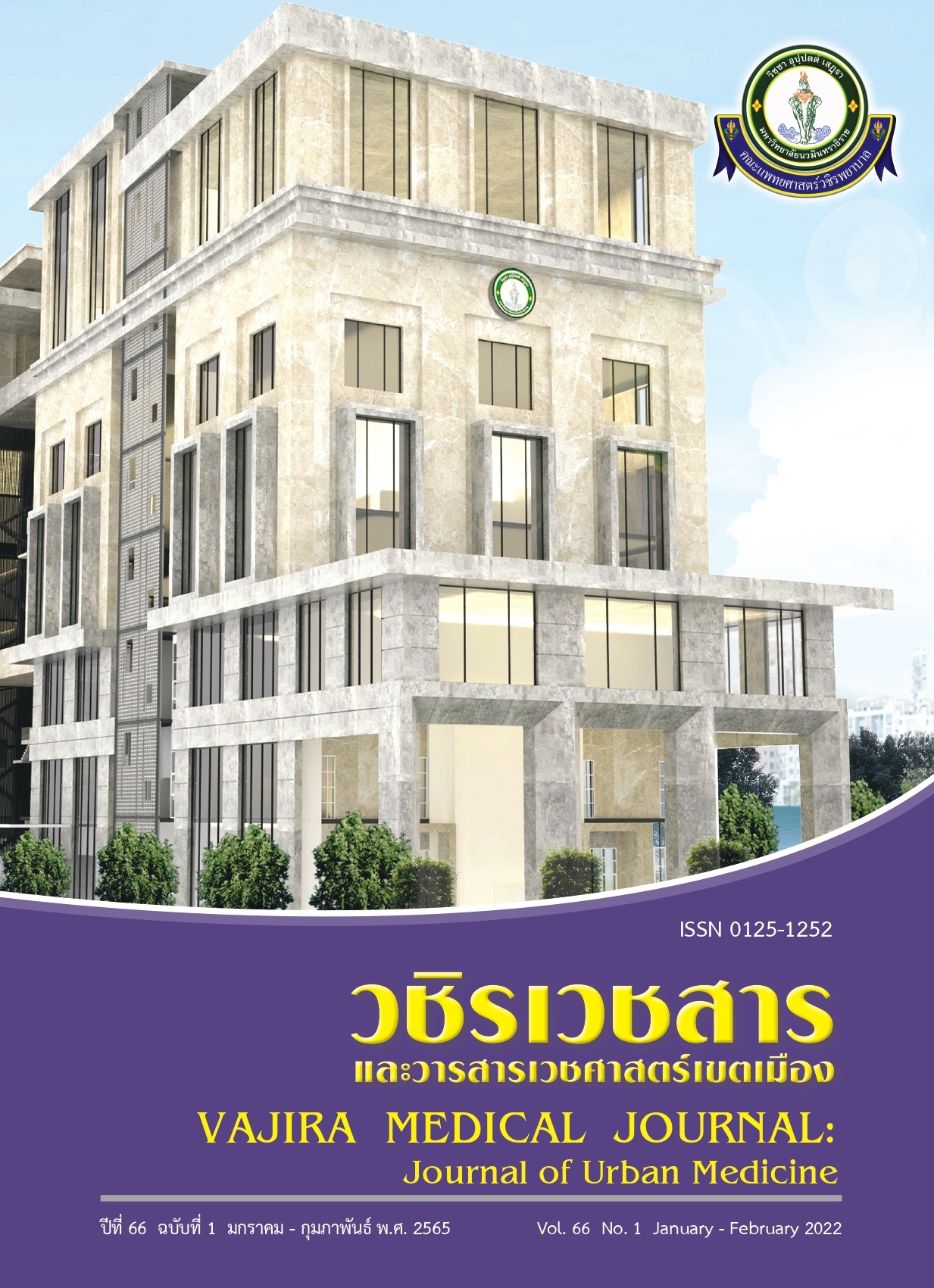Comparison of Surgical Outcomes between a 12-Month Adjustable Intragastric Balloon Placement versus Laparoscopic Sleeve Gastrectomy in Class I-II Obesity: A Retrospective Study
Main Article Content
Abstract
Objective: To compare weight loss between intragastric balloon (IGB) and laparoscopic sleeve gastrectomy (LSG) in patients with class I-II obesity.
Materials and Methods: The authors retrospectively reviewed data of obese patients with a body mass index (BMI) of 30-40 kg/m2 who underwent LSG or IGB in Vajira hospital from January 2012 to December 2017. The primary outcome was percent excess weight loss (%EWL), and secondary outcomes were improvement in co-morbidities, rate of complications, and changes in quality of life at 12 months after procedures.
Results: Sixteen patients who underwent either LSG (n = 9) or IGB (n = 7) were enrolled. There were no significant differences in baseline characteristics except co-morbidity status. The median (interquartile range) %EWL following LSG and IGB placement was 67.8 (61.3, 81) and 20.5 (2.5, 34), respectively, at 12 months (p-value = 0.001). Most co-morbidities were improved or resolved after LSG, but none of them was improved after IGB placement. Complications and quality of life were not significantly different following either intervention.
Conclusion: Results suggest that LSG may be more suitable than IGB placement for patients with class I–II obesity in terms of both weight loss.
Downloads
Article Details

This work is licensed under a Creative Commons Attribution-NonCommercial-NoDerivatives 4.0 International License.
References
World Health Organization. Obesity and overweight 2018 [Internet]. 2020 [cited 2020 January 5]. Available from: https://www.who.int/news-room/fact-sheets/detail/obesityand-overweight
World Health Organization. Regional Office for the Western Pacific. The Asia-Pacific perspective: redefining obesity and its treatment. Sydney: Health Communications Australia [Internet]. 2000 [cited 2020 January 5]. Available from: https://apps.who.int/iris/handle/10665/206936.
Widlansky ME, Sesso HD, Rexrode KM, Manson JE, Gaziano JM. Body mass index and total and cardiovascular mortality in men with a history of cardiovascular disease. Arch Intern Med 2004;164(21):2326-32.
Berrington de Gonzalez A, Hartge P, Cerhan JR, Flint AJ, Hannan L, MacInnis RJ, et al. Body-mass index and mortality among 1.46 million white adults. N Engl J Med 2010;363(23):2211-9.
Lee WJ, Wang W. Bariatric surgery: Asia-Pacific perspective. Obes Surg 2005;15(6):751-7.
American Society for Metabolic and Bariatric Surgery. Estimate of bariatric surgery number, 2011-2017 [Internet]. 2020 [cited 2020 January 5]. Available from: https://asmbs.org/resources/estimate-of-bariatric-surgery-numbers.
Chang DM, Lee WJ, Chen JC, Ser KH, Tsai PL, Lee YC. Thirteen-year experience of laparoscopic sleeve gastrectomy: Surgical risk, weight loss, and revision procedures. Obes Surg 2018;28(10):2991-7.
Kikkas EM, Sillakivi T, Suumann J, Kirsimägi Ü, Tikk T, Värk PR. Five-Year Outcome of Laparoscopic Sleeve Gastrectomy, Resolution of Comorbidities, and Risk for Cumulative Nutritional Deficiencies. Scand J Surg 2019;108:10-6.
Ismail M, Nagaraj D, Rajagopal M, Ansari H, Nair M, Hegde A, et al. Seven-year outcomes of laproscopic sleeve gastectomy in indian patients with different classes of obesity. Obes Surg 2019;29:191-6.
Nieben OG, Harboe H. Intragastric balloon as an artificial bezoar for treatment of obesity. Lancet 1982; 1(8265):198-9.
Gleysteen JJ. A history of intragastric balloons. Surg Obes Relat Dis 2016;12(2):430-5.
Kim SH, Chun HJ, Choi HS, Kim ES, Keum B, Jeen YT. Current status of intragastric balloon for obesity treatment. World J Gastroenterol 2016;22(24):5495-504.
Machytka E, Klvana P, Kornbluth A, Peikin S, Mathus-Vliegen LE, Gostout C, Lopez-Nava G, Shikora S, Brooks J. Adjustable intragastric balloons: a 12-month pilot trial in endoscopic weight loss management. Obes Surg 2011;21(10):1499-507.
Brooks J, Srivastava ED, Mathus-Vliegen EM. One-year adjustable intragastric balloons: results in 73 consecutive patients in the U.K. Obes Surg 2014;24(5):813-9
Genco A, Cipriano M, Materia A, Bacci V, Maselli R, Musmeci L, et al. Laparoscopic sleeve gastrectomy versus intragastric balloon: a case-control study. Surg Endosc 2009;23(8):1849-53.
Çaycı H, Erdogdu UE. Laparoscopic sleeve gastrectomy versus endoscopical intra-gastric balloon placement: early results of morbidly obese patients. Arch Clin Exp Med 2017;2(2):35-8.
Dindo D, Demartines N, Clavien PA. Classification of surgical complications: a new proposal with evaluation in a cohort of 6336 patients and results of a survey. Ann Surg 2004;240(2):205-13.
Pattanaphesaj J, Thavorncharoensup M. EQ-5D-5L Questionnaire (Thai version) [Internet]. 2019 [cited 2019 January 16]. Available from: https://www.hitap.net/wp-content/uploads/2014/11/Thai5L_brief_Aug2017.pdf. In Thai.
Velanovich V. The development of the GERD-HRQL symptom severity instrument. Dis Esophagus 2007;20(2):130-4.
Papamargaritis D, le Roux CW, Sioka E, Koukoulis G, Tzovaras G, Zacharoulis D. Changes in gut hormone profile and glucose homeostasis after laparoscopic sleeve gastrectomy. Surg Obes Relat Dis 2013;9(2):192-201.


